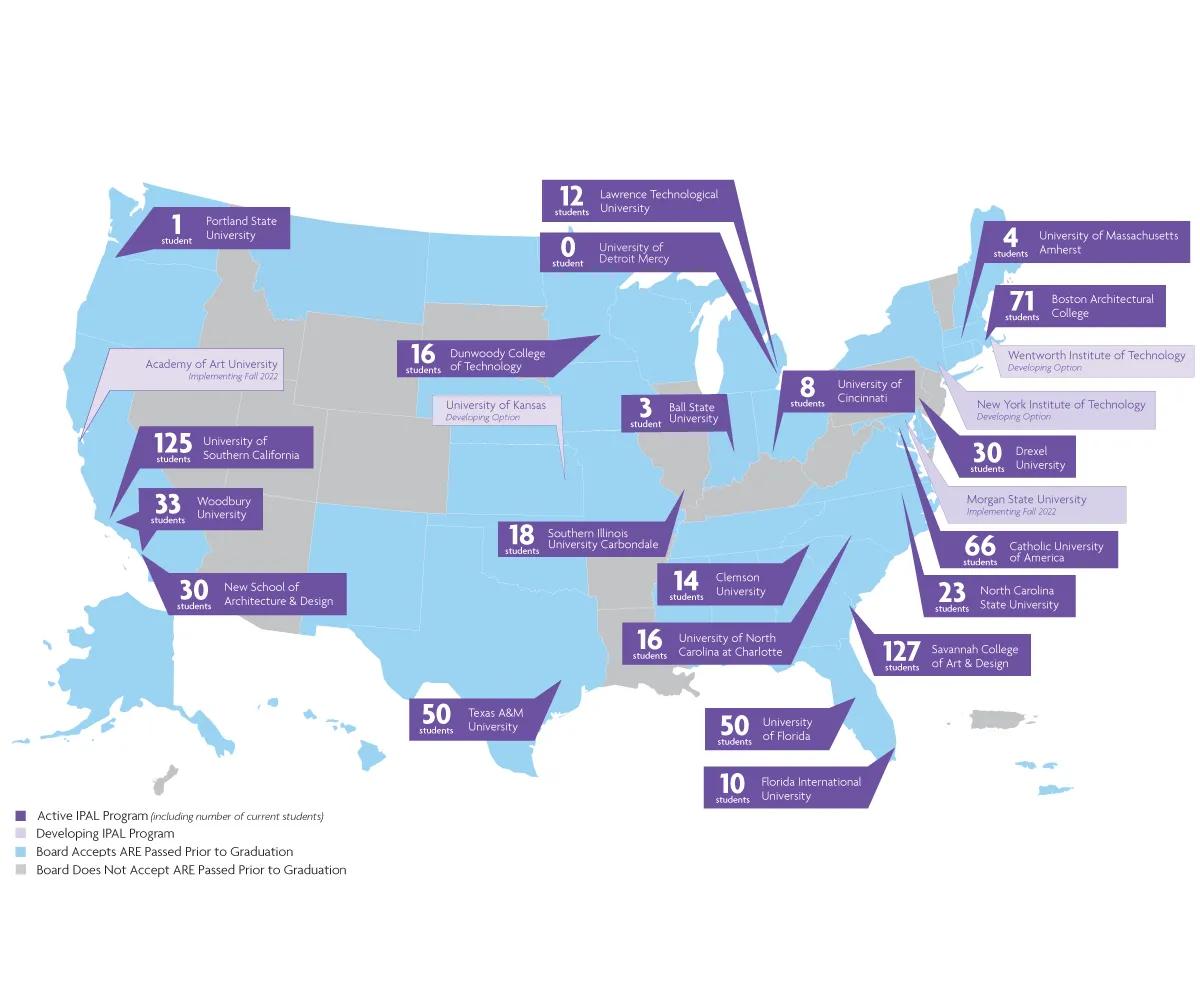
Earning a degree from an architecture program accredited by the National Architectural Accrediting Board (NAAB) is the most common path for candidates seeking architectural licensure in the United States. Data continues to show that, on average, licensure candidates with a degree from a NAAB-accredited program have greater success when taking the national licensing exam—although they also take longer to complete both the exam and the experience program.
Interest in the Integrated Path to Architectural Licensure (IPAL) continues, with over 600 students enrolled in IPAL options across the country during the 2020-2021 school year. Additionally, just over half of newly licensed architects started their NCARB Record while in school, suggesting that NCARB’s continued efforts to raise early awareness of the licensure process are helping students make early progress on their path.
NAAB data shows that over 8,200 new students enrolled in a NAAB-accredited program in the 2020-2021 school year—a 3% increase from the previous school year. Of the new students, 47% are enrolled in Master of Architecture programs, and 52% are enrolled in Bachelor of Architecture programs. Less than 1 percent are enrolled in Doctor of Architecture programs. Just over half of new students are women (51%), which is 3 percentage points higher than the proportion of female candidates reporting experience. This suggests that NCARB may see greater gender representation on the licensure path in the years to come.
Note: This data is provided to the NAAB by accredited programs and will be published in the 2021 NAAB Report on Accreditation in Architecture, available atwww.naab.org. Students enrolled in non-accredited architecture programs are not represented.
Nearly 28,000 students were enrolled in a NAAB-accredited program in the 2020-2021 school year, an increase of 3% compared to the previous academic year. This is the fourth consecutive year of steady increases. Of these students, 62% are enrolled in Bachelor of Architecture programs, 38% in Master of Architecture programs, and less than 1 percent in Doctor of Architecture programs. Forty-nine percent are men, and 51% are women.
In 2021, 6,275 degrees were awarded by NAAB-accredited programs across the country, a 3% increase compared to the previous school year. This is above the average number of graduates seen over the five years (6,102). Of these graduates, 49% were men and 51% were women—a 1 percentage point increase for women compared to 2020.
Just over half (51%) of architects who became licensed in 2021 started their NCARB Record while they were in school—a 1 percentage point decrease compared to 2020.
Creating an NCARB Record is one of the first steps on the path to licensure, and NCARB’s data shows that, on average, the sooner a candidate starts their NCARB Record, the sooner they will become licensed. NCARB encourages candidates to start their Record once they begin earning experience that counts toward the experience program.
Note: Historical data can shift because licensure candidates can backdate AXP experience up to five years.
In 2021, approximately one in five (18%) newly licensed architects did not hold a degree from an architecture program accredited by the NAAB—a 1 percentage point increase compared to 2020. The proportion of new architects without a degree from a NAAB-accredited program has been steadily rising over the past five years.
Out of the 55 U.S. jurisdictions, only 17 will license individuals who don’t hold a degree from a NAAB-accredited program (typically by substituting additional experience in lieu of a professional degree).
Due to the rising costs of higher education and the disproportionate impact those costs can have on underrepresented groups in the profession, NCARB and its member licensing boards are exploring opportunities to introduce a more accessible—but still rigorous—education option into the licensure process.
In 2021, graduates of NAAB-accredited architecture programs took an average of 4.9 years to complete the AXP. Graduates of non-accredited programs completed the ARE in 4.3 years—an average of 7 months sooner.
The majority of individuals completing the AXP hold a degree from a NAAB-accredited program. The thickness of the lines indicates the number of individuals in the group. Because more candidates completed the AXP in 2017 than in 2021, the line for graduates of NAAB-accredited programs is thicker near that year.
The average time to complete the AXP rose 2020-21 for both groups, likely an ongoing result of the COVID-19 pandemic.
In addition to completing the AXP in less time, graduates of non-accredited programs also typically complete the ARE seven months sooner than graduates of NAAB-accredited programs.
In 2021, graduates of non-accredited programs who completed the exam took an average of 2.2 years, a slight decrease compared to 2020. Meanwhile, graduates of NAAB-accredited programs took an average of 2.8 years, a slight increase compared to 2020.
As with the previous chart, the thickness of each line indicates the relative size of the group it represents. Because most individuals completing the ARE have graduated from a NAAB-accredited program, the line is thicker for that group.
Although graduates of NAAB-accredited programs take longer on average to complete the exam, they also see higher average pass rates. In 2021, graduates of NAAB-accredited programs had an overall exam pass rate of 56%, compared to 51% for graduates of non-accredited programs. This suggests that graduates of NAAB accredited programs pass the exam in fewer attempts, but space their attempts further apart.
The average overall ARE pass rate for all candidates in 2021 was 55%.
In 2021, graduates of NAAB-accredited Master of Architecture (M.Arch.) programs saw an average ARE pass rate of 57%. This is 4 percentage points higher than the average pass rate for graduates of NAAB-accredited Bachelor of Architecture (B.Arch.) programs.
The pass rates for both M.Arch. and B.Arch. graduates are higher than the average pass rate for graduates of non-accredited programs (51%).
IPAL Initiative Continues to Grow

There are currently 28 NAAB-accredited programs at 24 colleges participating in NCARB’s Integrated Path to Architectural Licensure (IPAL) initiative, which launched in 2015.
The IPAL option—offered as an additional path within an existing NAAB-accredited program—seeks to shorten the time it takes to become an architect for students dedicated to earning a license. Participating programs provide students with the opportunity to complete the AXP and take all six ARE 5.0 divisions prior to graduation.
During the 2020-2021 school year, over 600 students were enrolled in IPAL options across the United States. Currently, 34 boards will accept licensure applications from candidates who have completed the ARE prior to graduation through an IPAL program.
Note: Enrollment data is from the 2020-2021 school year. Some accepted programs are still developing their IPAL options.
